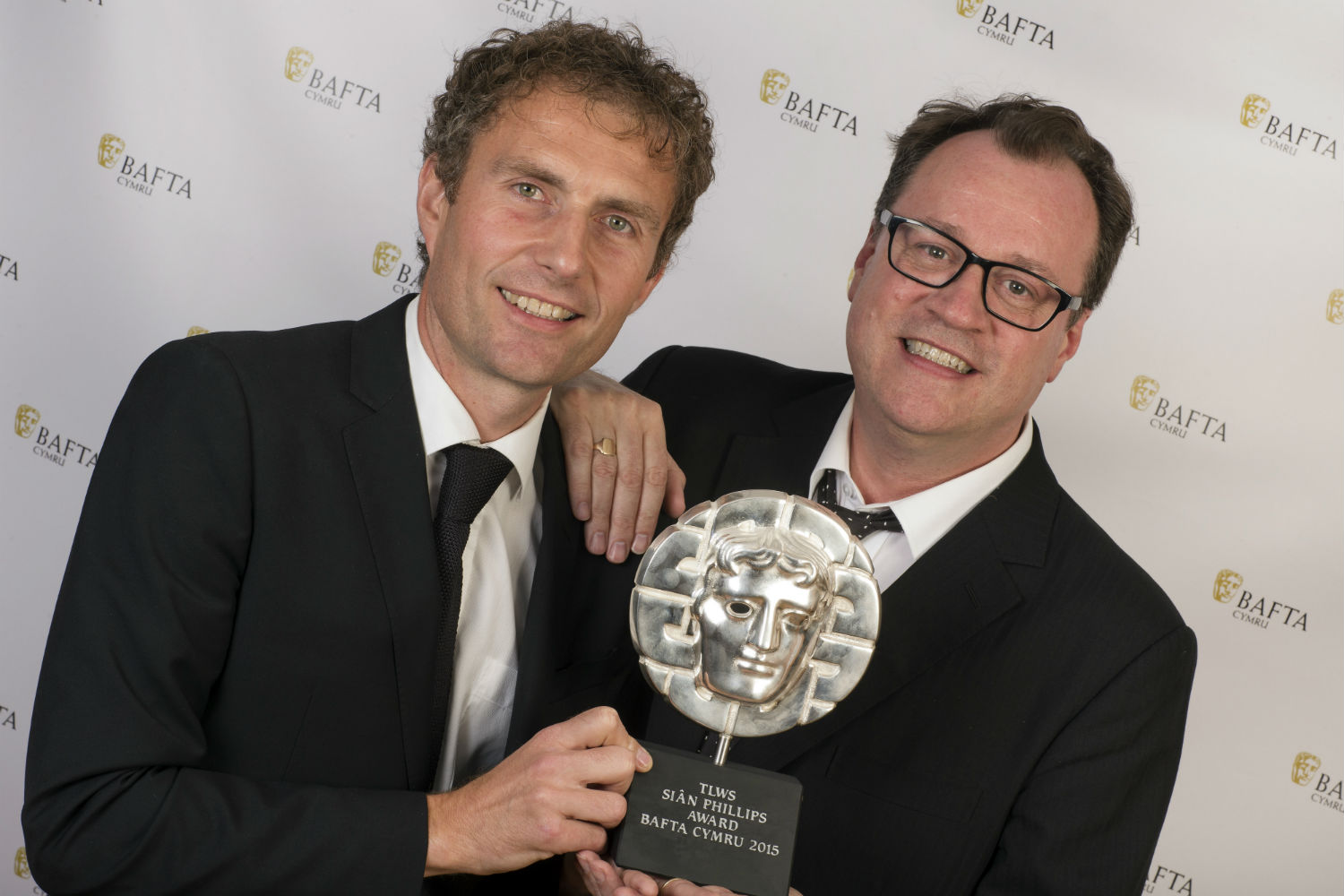
Director Euros Lyn and writer Russel T Davies with the Sian Phillips award which was presented to Euros by Russel at the ceremony.
Last Sunday, our dragon roared in celebration of the talents of this country, why I hear you ask?
Last Sunday was the 2015 BAFTA Cymru Awards, a buzzing celebration of Wales’ talent, and blooming attraction to international shows and films, with the public watching amongst home grown stars.
Wisdom –easy to receive, hard to listen to – certainly when your brain has a series of buffers and filters to make the challenge of it getting in there that tad bit more exciting, the cogs and emotions of your brain cheering on the wipe out style spectacle before them. Luckily, wisdom is astronomically better fated straight from the horse’s mouth – when the ‘horse’ is another thing entirely. An institution of a show runner, a brilliant, lauded writer, Russel T Davies. The chestnut in question- “just write” Which of course, I am in the process of doing, somewhat strangely with the same, utterly euphoric glee that came over me, and all spectators during the event.
This buzz, according universally to the winners and hosts of the event, is reflected in the unlimited potential of Wales. This potential has, according to, among others, winning director Euros Lyn always been here, but is now being sought ought internationally, with shows like The Bastard Executioner recognising our well of talent.
Each and every interview, however long or short, showed this talent just as easily as the ceremony and awards themselves, with insight into special effects, saying great effects must be ‘wedded to the story’, Director Clare Sturges with her aim to humanise and to stop victim blaming in ‘Sex Work love and Mr Right’, and that tenacity and ‘keenness’ are the first essential steps to arriving in the industry, ready to work for getting to a standard for events like these – something I, as an aspiring writer, would leap at, both hands waiting, despite dyspraxia producing some (light) trauma in the form of PE flashbacks, ready to catch the chance.
No, not even turning the poor saucer of my coffee cup into a small lake could put a damper on the evening. Though slightly soggy. (I shall not, as my friends know full well, ever be up for a comedy award!)
With meeting a childhood icon, industry greats and new friends in the form of the other critics, the buzz is almost certain to remain whenever the memory is looked at, as fondly and excitedly as the night was lived through.
This is as good an incentive as any to have faith in our TV and film, to support upcoming projects and look again at ones past. Among the winners were Euros Lyn, Clare Sturges, Rhod Gilbert, Mali Harries and Gruff Rhys, with Hinterland, Jack to a King and Set Fire to the Stars some of the luckiest projects on the night.
The full list of winners can be found here;
http://www.bafta.org/wales/awards/news/winners-announced-british-academy-cymru-awards-2015.
Category Archives: Film & TV
BAFTA Cymru Awards 2015 by James Briggs

All of the stars were out in force on Sunday the 27th of September at St David’s Hall, Cardiff to attend the annual BAFTA Cymru awards. With the red carpet out and public awaiting the arrival of Wales’ television and movies biggest stars the atmosphere was electric, with plenty of autographs being signed and pictures being taken.
One highlight of the red carpet for me was being able to meet and interview my idol, Russell T Davies. What a really nice guy, so down to earth and a pleasure to chat with. Disappointingly though, he told us that his hit series Cucumber will not be returning for a second series as it was written purely to be for one series only but there seems to be lots more to come from him.
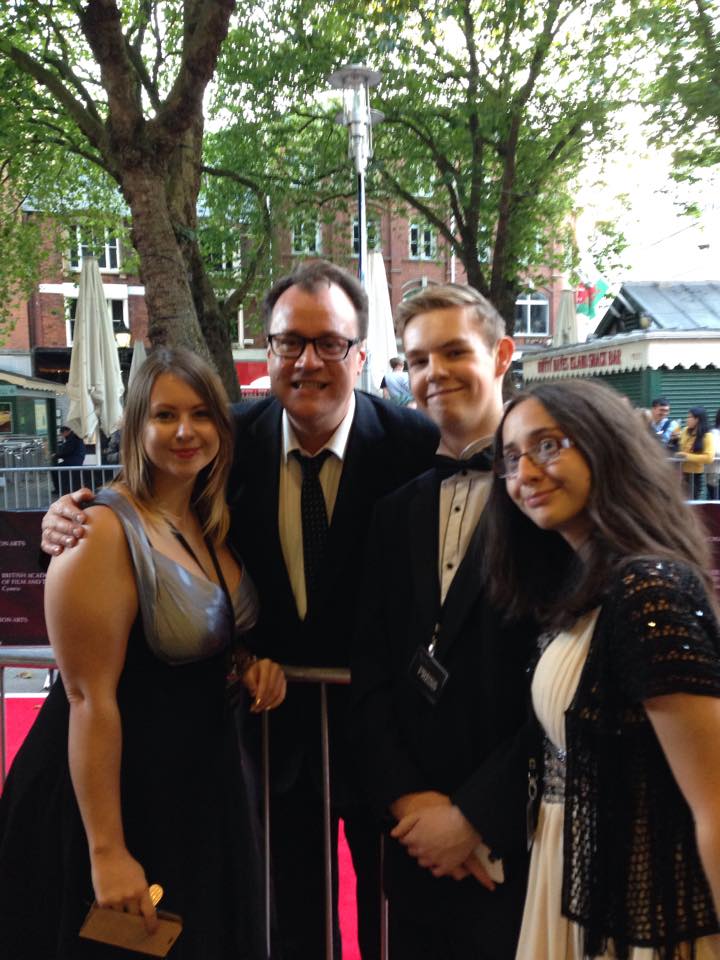
The Young Critics meet Russell T Davies
After the excitement of the red carpet, we made our way to the press interview room, where we were lucky enough to meet and interview some of the award winners and presenters. Their excitement at winning a Welsh BAFTA was evident and it was a great experience to interview many famous faces such as Gruff Rhys, the renowned and well deserved winner Euros Lyn and the Production team for Jamie Baulch – Looking for my Birth Mum to name but a few.
It was evident from many of the winners that they appreciated winning a BAFTA Cymru award. You could see that whether they were in front of the camera or in the production teams that it was an amazing achievement and one that they would cherish. For some, who had started from humble beginnings, were happy to share their stories and by winning an award for their hard work they had achieved one of their ultimate goal by receiving such a prestigious award. Everyone who attended the awards, be they in front or behind the camera, were all inspirational and really did make you feel that you should chase your dreams and one day you may be lucky enough to be collecting a BAFTA yourself.
So, overall a truly magical evening that allowed fans of Welsh TV and Film to come out and join in with the celebrations of what Wales has achieved. We wait in anticipation and look forward to seeing what the coming year will bring us in the world of Welsh film and television.
Review Agent Carter, Ep1 Season1 by Amina Elmi
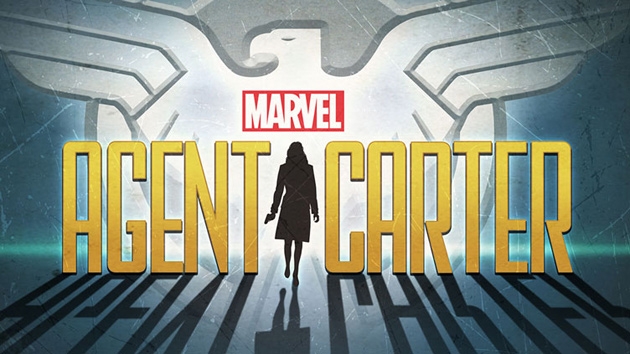
The Marvel Cinematic Universe has dominated the box office over these past few years and it is only getting stronger. It seems only fitting that it spreads to the small screen as well. Marvel’s Agents of SHIELD is about to start its 3rd series in September and many fans are looking forward to it. Agents of SHIELD has created the path for Marvel’s latest series Agent Carter.
Agent Carter continues on with some of the most loved characters from the first Captain America film. The first episode begins where the movie ended. We see a heartbroken Peggy attempting to move with her life after the loss of Steve.
The show is set after the Second World War where Peggy Carter continues to work as an agent. After Peggy’s work in the war, you would at least think she would be treated equally by her co-workers, unfortunately not. Every day she battles sexism as well as the bad guys.
What I like most about Agent Carter is that it provides a role model for girls. Agent Carter is a strong, fearless woman who does not need anyone’s approval. Watching the show gives you a feeling that being a woman is not a disadvantage, it is an opportunity to show the world that you are just as capable.
“I don’t need Agent Thompson’s approval or the President’s. I know my value; anyone else’s opinion doesn’t really matter.” – Agent Carter S1 Ep8
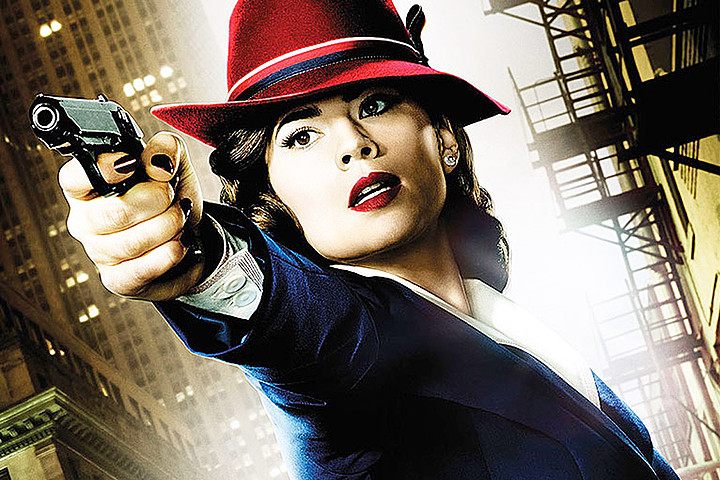
Hayley Atwell plays Peggy Carter brilliantly. She embodies what it is to be a strong woman. The fight scenes are choreographed really well and it is comforting to see a women kick-ass. Hayley is also really entertaining on social media. She is always engaging with fans, making funny videos and generally making people smile.
Agent Carter has taken the world by storm. Its success has allowed another series with more episodes for fans to enjoy. Even looking through pictures of San Diego Comic Con, I don’t think that many people have ever cos-played the same character. I am a massive fan of Agent Carter and can’t wait for what she gets up to next.
Agent Carter can be seen on Fox at 9pm on Sunday evenings in the UK.
Review Slow West Chapter Arts Centre by James Knight
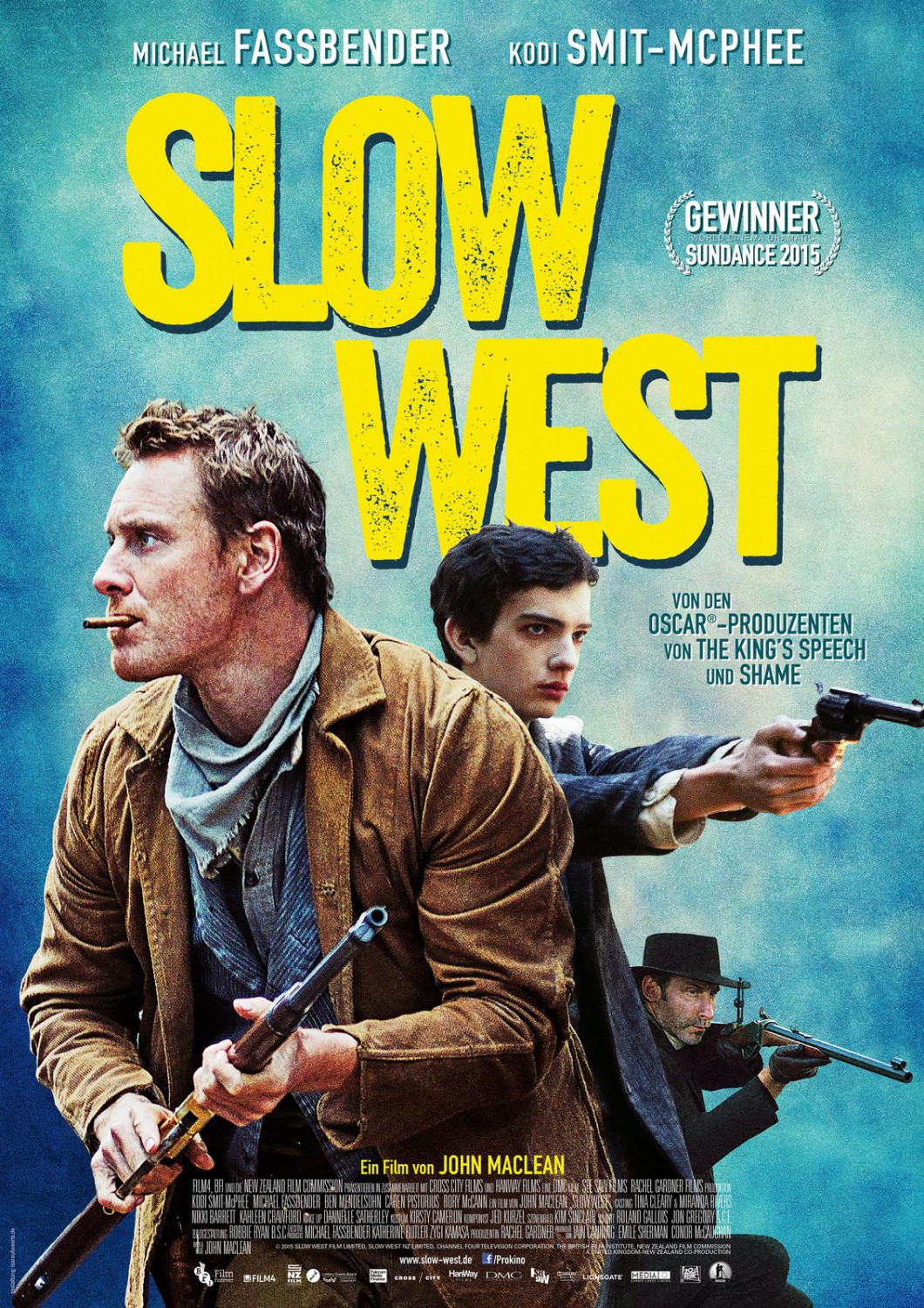
In Martin McDonagh’s 2008 film In Bruges, Colin Farrell turns to Brendon Gleeson and says, ‘Purgatory’s kind of like the in-betweeny one. You weren’t really s**t, but you weren’t all that great either. Like Tottenham.’ John Maclean’s Slow West is a Purgatory-esque new Western that doesn’t reinvent the genre, nor will it reboot it, but just like Spurs, it’s still entertaining.
Scottish filmmaker Maclean’s debut feature tells the story of sixteen year old Jay Cavendish (Kodi Smit-McPhee) as he travels west across nineteenth century Colorado in search of his one and only love Rose (Caren Pistorius), who previously left Scotland with her father. On the way he employs outlaw with a shady past Silas (Michael Fassbender) to safeguard his journey through the dangerous forests and vast open landscapes of the American West.
The history of the Western is essentially the history of movie star charisma. From Jimmy Stewart, to John Wayne, to Robert Mitchum, to Gary Cooper, to Clint Eastwood, to Henry Fonda, not forgetting a little dash of Walter Brennan here and there, the genre has always been a driving force for star quality and personality. Slow West however, is a lonely desert when it comes to charisma. As Silas, Fassbender makes no mistakes but then again he takes no risks, he doesn’t play a personality but instead a ghost, and an uninteresting one at that. But maybe he has no personality to give, which seems to be the modern trend with this recent batch of new movie actors where less is more seemingly because they have nothing more than less to give so less becomes less, i.e. Tom Hardy, Taylor Kitsch, and so on and so on. Smit-McPhee’s most notable performance to date alongside Viggo Mortensen in John Hillcoat’s The Road, is a film not to dissimilar in structure to Slow West, but whereas The Road is brutal and barbaric, Slow West is rather sophomoric in its nihilism and at times Disney in its visuals and cinematography (that is until a brilliant sequence right at the end of the picture when Maclean shows us one by one a conveyer belt of dead bodies, each framed thoughtfully and poignantly that will match anything in The Road).
Despite its flaws, the film is lean, brisk, and well-paced with a gentle but interesting rhythm. The film culminates in a well-directed shootout that’s littered with brilliant point of view shots from outlaws who hide out in picturesque cornfields, whilst before that there’s a wonderful sequence between Jay and Werner (Andrew Robertt), a nomadic writer researching Indian tribes, which stands out above everything else in the picture. Maclean also dresses the film with the odd moment of welcome surrealism with the score in particular sounding like something straight out of Jim Jarmusch’s Dead Man.
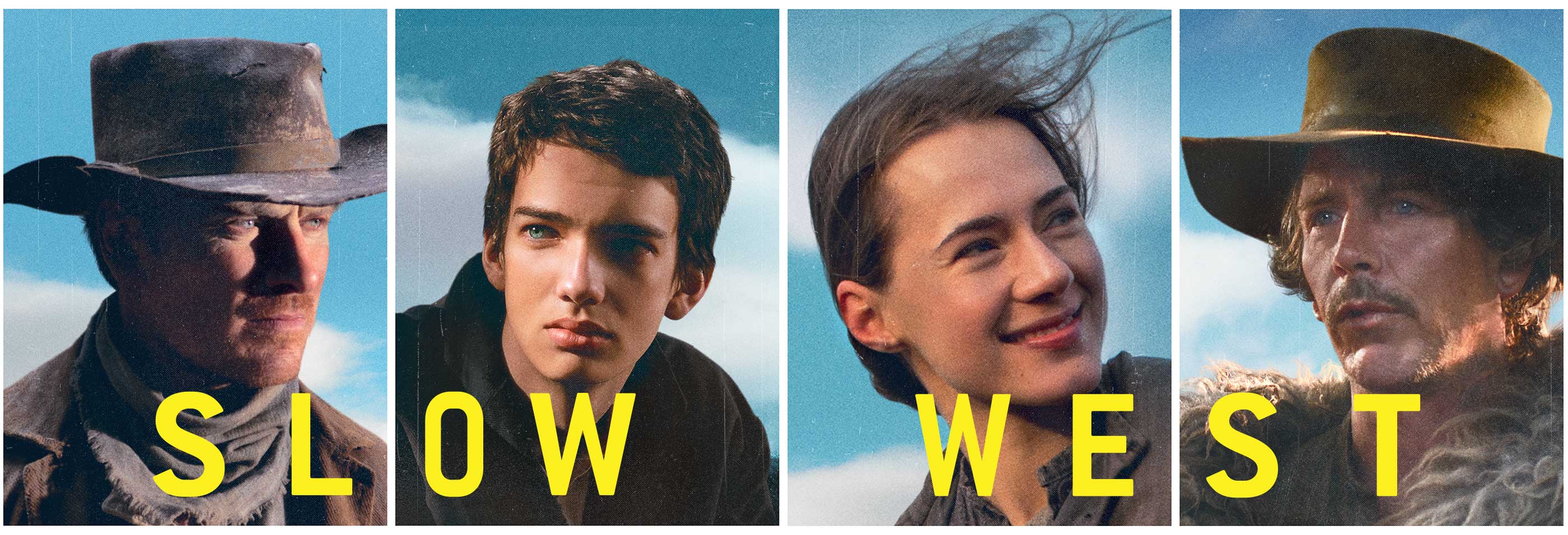
The Western genre in its most classical sense, once the most popular of genres has become in recent times nothing more than a memory. What contemporary cinema gives us instead is not the Western in terms of setting, but a Western in terms of mood and tone, No Country for Old Men for instance, is essentially a modern Western even though it’s set in the South. The problem with Slow West is, it neither feels like a classical Hollywood Western, nor a contemporary one like No Country, there’s a distant lack of authenticity (for instance, filming took place in New Zealand instead of Colorado and this shows throughout), it is a film very much in Purgatory in that sense. With a misleading title the film is neither slow nor is it really a Western, but whatever it is, it’s pretty good nonetheless.
Slow West (15)
USA/2015/84mins/15. Dir: John Maclean. With: Ben Mendelsohn, Michael Fassbender, Kodi Smit-McPhee.
At Chapter Arts Centre until July 2nd
– See more at: http://www.chapter.org/slow-west-15#sthash.dmtmc3Hy.dpuf
Review This is How We Die, Chapter Arts Centre by James Knight
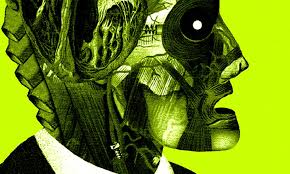
Hunter S. Thompson’s 1971 novel Fear and Loathing in Las Vegas begins famously with, ‘We were somewhere around Barstow on the edge of the desert when the drugs began to take hold.’ Christopher Brett Bailey’s This Is How We Die seems to carry on from where Thompson left off in this brilliant piece of spoken word black comedy theatre that will shudder you to your very core, and then shudder your core’s core, and then your core’s core core (if that’s even a thing, if it is then this play will find it and shudder it).
Bailey seems to appear on stage out of nowhere, he nods politely to the audience before sitting down at a desk which houses a microphone, a glass of water, a lamp, and Bailey’s script. Then an explosion occurs, an explosion of words that is. Bailey uses the microphone like a drum that he thumps and thumps with words that bounce off the microphone and splatter into the faces of the audience before punching their way into their souls. Through sheer physicality of his lips, tongue, and his bobbing head, Bailey brings his prose to life as spit flies, sweat flies, and emotions whiz. Reading mostly from his script, Bailey keeps his eyes down away from the audience, creating a distance, before carefully choosing his moments to eyeball the onlookers in order to land a joke or an emotional punch.
If you’re the romantic sort and wished you could’ve been there so see Allen Ginsberg read “Howl” in 1955, see Charles Bukowski read live in California, go back to the fifties to see Lenny Bruce perform his “Meaning of Obscenity” or “Religions Inc” bits, or have the desire to see William Burroughs’ Naked Lunch come to life before your eyes then this is the show for you. The musicality of Bailey’s almost word perfect performance conjures images of contemporary rap, but also the music of Tom Waits, in particular his song “Step Right Up”, but as if Waits’ music had been sucked into a David Cronenberg film and come out looking like the love child of David Lynch’s Eraserhead and Samuel Beckett’s Not I.
This Is How We Die is almost impossible to process, but maybe that’s its purpose, we will be forever trying to process it, forever trying to get to grips with it, maybe that is what makes it art. It deals mainly with the void and the space in between Bailey and the audience, after the performance Bailey took part in an impromptu Q&A session which in its formal reality seemed fake, there was an ugly space between him and the audience asking the questions, yet his performance on stage with all its fantastical absurdities seemed utterly real and utterly truthful.
This Is How We Die takes us into the blackness (both emotionally and literally via some genius lighting cues), engulfing us in the darkness of humanity. It is truly a battering of the senses where emotions pour out uncontrollably. With the final and resounding emotion being that of sheer amazement.
THIS IS HOW WE DIE
At Chapter Arts Centre – June 23rd at 7:30
Written and performed by Christopher Brett Bailey
Musicians: George Percy, Alicia Jane Turner, Christopher Brett Bailey, and Apollo
Dramaturg: Anne Rieger
Lighting Design: Sherry Coenen
Production Manager: Alex Fernandes
Producer: Beckie Darlington
Review Knife in the Water By James Knight

In 1941 there was Citizen Kane (Orson Welles), in 1955 there was The Night of the Hunter (Charles Laughton), in 1959 there was The 400 Blows (Francois Truffaut), in 1960 there was Breathless (Jean-Luc Godard), in 1969 there was Easy Rider (Dennis Hopper), in 1989 there was Sex, Lies, and Videotape (Steven Soderbergh), and in 1992 there was Reservoir Dogs (Quinten Tarantino), all great directorial feature debuts, but add to that list Roman Polanski’s 1962 maiden effort Knife in the Water, playing at Chapter Arts Centre as part of Martin Scorsese’s “Masterpieces of Polish Cinema” series.
The story of Knife in the Water is simple; a bourgeois sportswriter named Andrej, played by Leon Niemmczyk, and his wife Krystyna, played by Jolanta Umecka (making her onscreen debut, who Polanski discovered one day at a local swimming pool), pick up a hitchhiker known only as the Young Man (we never learn his name), played by Zygmunt Malanowicz, and take him with them on a sailing trip, with the vast majority of the film taking place on the boat. On paper this might seem like a smooth but forgettable little thriller but add in the Polanski touch and it evolves into an erotically charged psychological game of cat and mouse all with the accompaniment of Krzysztof Komeda’s masterful jazz score. Knife in the Water, alongside Chinatown (1974), the greatest neo noir detective film ever made, and Rosemary’s Baby (1968), possibly the greatest human horror ever made, have firmly established Polanski as a master of cinema. But unlike other filmmakers featured in this series, the likes of Andrej Wajda and Krzysztof Kielowski, Polanski’s films, especially Knife in the Water, are almost completely void of any political and social commentary. His films are a lot more interested in cinema, in the reality of a reflection rather than a reflection of reality (to steal Godard’s wonderful term). Knife in the Water does not take place in Poland but in Pol-anski-land.
In his autobiography, Polanski recalled the difficulties he and his crew encountered whilst shooting Knife in the Water, saying; ‘the yacht was quite big enough to accommodate three actors but uncomfortably cramped for the dozen-odd people behind the camera. When shooting aboard, we had to don safety harnesses and hang over the side.’ Yet from this confinement, Polanski manages to liberate the camera, almost creating a new set of cinematic rules in the process. The film is a technical marvel. It reminds me of another Polish film, The Night Train (1959), indecently also starring Leon Niemczyk, where the director Jerzy Kawalerowicz, also managed to create a technically impressive film despite having to shoot the entire picture inside a moving train.
Knife in the Water is a cinema first film, image and sound hold far greater precedent over dialogue which in the film is often meaningless and empty and carries no weight in the telling of the story (in fact the majority of the dialogue is dubbed, with Polanski giving his own voice to the character of the Young Man). Towards the end of the film when the sailing trip has come to an end, there’s a sequence where Andrej and his wife lock up the boat in harbour, they tie up the ropes, put down the sails, padlock the doors, all without one word of dialogue. On the surface it’s an innocent little sequence but look a little closer and you’ll see that Polanski manages to capture their whole marriage through raw image, sound and simple action, no dialogue, like a true master of cinema.
Like Polanski’s two most recent films, Knife in the Water deals with a limited cast, but whereas Venus in Fur (2013), and Carnage (2011) through their limitations become essentially filmed theatre, Knife in the Water is cinema and cinema only. It is ninety minutes of pure intimacy where we too feel like we’re on that boat with them. When it’s all over we realise that we’ve learned nothing concrete about the characters yet we somehow know everything that’s important. The film ends where it began, no one changes, no one grows, yet there’s a sense of a new beginning.
In one scene, the Young Man hangs over the edge of the moving boat and by hovering his feet over the surface of the water makes it look like he is in fact walking on water. Knife in the Water is such a cinematic achievement that whilst watching it, you can’t help but get the sense that Polanski too was walking on water.
Knife in the Water (PG)
Poland/1962/94mins/subtitles/PG. Dir: Roman Polanski. With: Leon Niemczyk, Jolanta Umecka, Zygmunt Malanowicz.
At Chapter Arts Centre from June 28th – 30th
– See more at: http://www.chapter.org/knife-water-pg#sthash.jqBSid1t.dpuf
Review: Ashes and Diamonds Chapter Arts Centre By James Knight
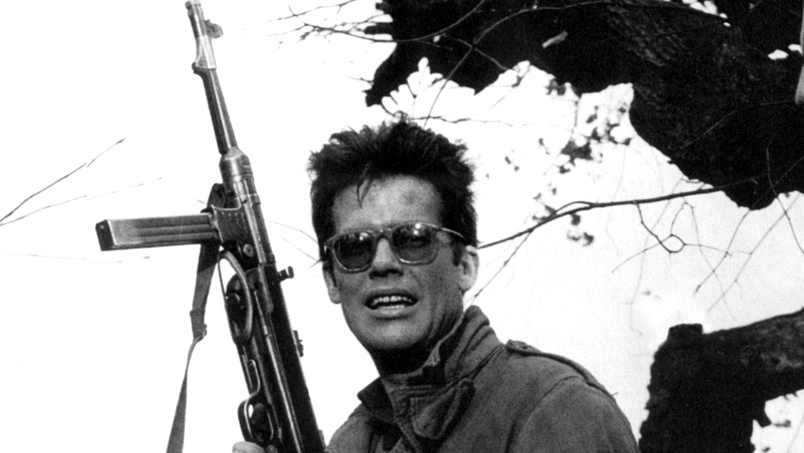
The first image we see in Andrej Wajda’s Ashes and Diamonds is that of a cross on top of a small chapel. The camera pans down to find three men laying on the grass next to the chapel, one of them is sleeping. An innocent little girl appears and asks one of the men to open the chapel door for her. A nice summery image for a pleasant summer’s day somewhere in Poland. Then in the distance a car approaches, the men rush to their feet, each brandishing machine guns and tell the little girl to get lost. Bullets fly, the car comes crashing to a halt, the driver falls out, machine gunned to death. The passenger makes a run for it, bangs on the locked door of the chapel, but he has nowhere to go. The three men machine gun him to his death, as he falls he bursts into flames at the door of the chapel. One of the three men then panics, ‘let’s get out of here,’ he wails, and we realise that we’re not watching super cool hitmen but real human beings caught up in civil unrest in Wajda’s most humanistic of films. Later, after the three men have fled we realise that they’ve killed the wrong people as their intended target arrives on the scene. A worker surveying the dead bodies then asks, ‘can you tell us how long people will have to die like this?’ Ashes and Diamonds is a film that asks the toughest of questions.
Presented as part of Martin Scorsese’s “Masters of Polish Cinema” series, the film features in Scorsese’s list for his choice for the ten greatest films ever made in the 2012 Sight & Sound poll. The film is a key component of Polish new wave cinema, one of the most stylish of national cinema movements and just like the French new wave which came hot on its heels, Wajda and his fellow filmmakers managed to expand on the cinematic foundations laid forth by the Italian neo realists in the mid 1940’s.
Ashes and Diamonds is essentially the third part in Wajda’s unofficial war trilogy, although enjoyment of the film is not dependent on viewing the previous two. In the previous two films, A Generation (1955) and Kanal (1957), which both concern themselves with the Polish uprising during the Second World War, there is, despite the bloodshed amongst the upheaval of human morality, a great deal of hope and idealism. But come Ashes and Diamonds, this hope has evaporated and instead been replaced with despair. Even in spite of the fact that the Nazis have surrendered which people hear about over a loudspeaker yet barely react to, there is no Times Square esque V-J Day celebrations here, because for the first time since the war started, people can now envisage their futures and they don’t like what they see. Fighting the Nazis united them in hope, but now the war is over and the only people left to fight is themselves.
Set over twenty four hours in 1945, the overriding narrative of the film deals with the civil conflict between the pro-Russian People’s Army and the UK backed Home Army. The film is both a war tale and a tragic love story whilst also having the feel of an American hang out movie. The star of the film, Zbigniew Cybulski, incidentally one of the three shooters we meet in the opening scene, was often known, thanks largely to this performance, as the Polish James Dean. He certainly has Dean’s coolness and playfulness, whilst his impulsiveness throughout the film conjures up the image of Dean jumping from roof tops in Elia Kazan’s East of Eden (1955). Cybulski’s performance, his actions, his facial expressions, manage to capture the melancholic nostalgia of the story and of post war Poland, he says things like, ‘nothing in this country is serious anymore.’ He meets a girl, the wonderful and beautiful Ewa Kryzewska, who works at a hotel bar who says things like, ‘I don’t want any goodbyes or memories to remember when it’s over.’ This is a film where every line of dialogue has meaning and significance.
On the surface at least, Cybulski is the star of the film, but the true star of Andrej Wajda’s Ashes and Diamonds is Andrej Wajda himself. The whole film is a one hundred minute masterclass in cinematic framing. In one scene, Wajda frames Cybulski’s collaborator in arms Andrej, played by Adam Pawlikowski, in a close-up as he talks on the phone inside a telephone booth, over his shoulder is Cybulski leaning on a bar, then behind Cybulski in walks Communist Commissioner Szczulka, played by Waclaw Zastrzezynski, the man who Cybulski and co were originally sent to kill. In one shot through expert framing Wajda manages to convey the entirety of the film’s emotions and conflicts with stark simplicity. Throughout the film Cybulski keeps coming face to face with his past, in one scene he sees the crying fiancé of one of the men he killed in the opening sequence. Cybulski stares at her and Wajda holds and holds Cybulski’s gaze in a close-up. There are no words spoken yet by dwelling on Cybulski’s face Wajda manages to convey all the actor’s emotions, it’s almost as if we can hear his thoughts. This is pure cinema.
The images in Ashes and Diamonds are so profoundly striking it is a film that could be watched and understood with the sound turned off. The film ends with an unforgettable sequence that you will carry around with you long after the final credits have rolled. It’s visual poetry from start to finish.
Ashes and Diamonds (12)
Poland/1958/104mins/subtitles/12. Dir: Andrzej Wajda. With: Zbigniew Cybulski.
At Chapter Arts Centre from June 7th – 9th.
– See more at: http://www.chapter.org/ashes-and-diamonds-12#sthash.2nExviZK.dpuf
Review The Ladykillers, Chapter Arts Centre, Cardiff by Barbara Michaels
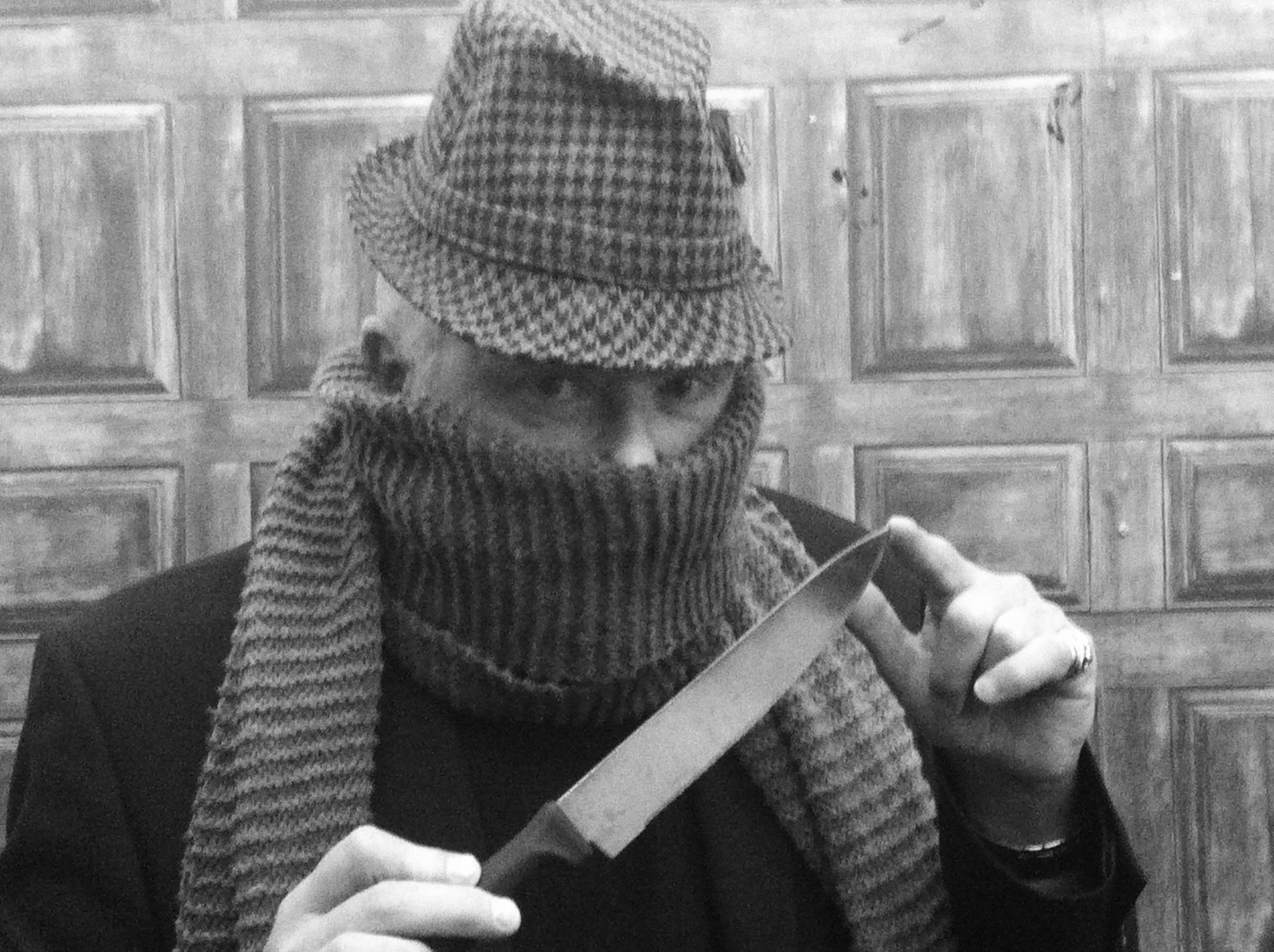
The Ladykillers at Chapter Arts Centre, Cardiff
Original screenplay by William Rose
Adapted by Graham Linehan
Production by Everyman Theatre
Director: Marie-Claire Costly
Reviewer: Barbara Michaels, Third Act Critic
Rating: [3.00]
Murder and mayhem are the buzzwords for William Rose’s comedy-thriller The Ladykillers. For those fortunate enough to have caught a screening of the Ealing Studios 1954 motion picture, Everyman Theatre’s production of the adaptation by Grahan Linehan will bring back fond memories. Who could forget the iconic performance by theatrical icon Alec Guinness as the crafty (and dotty) Professor Marcus?
Take an eccentric old lady living on her own with her parrot and add a gang of crooks masquerading as musicians who rent a room in which to plan a robbery and the scene is set for a series of mishaps. When the old girl, Mrs Wilberforce, discovers what they are up to there is only one solution – to bump her off before she turns them in. But that is not as simple a matter as it might seem – and neither, as it transpires, is the elderly widow who despite her old fashioned appearance might be more than a match for the bumbling ineptitude of the amateur criminals.
Characterisation and pace play a major part in putting on a play of this genre, where a great script full of humour should raise delicious giggles among the audience from start to finish. On opening night this sadly was not the case. It was not until a second half with increased momentum that the performance really got going and we were given a heartening glimpse of what the cast are capable of achieving. It is reasonable to expect things to improve later in the run, for Everyman Theatre has a good track record – their Oh What A Lovely War last year was tops.
As the “master criminal” Professor, Paul Fanning is believable although relying overmuch on twiddling his overlong scarf. Not quite dotty enough for this critic, although the Prof’s darker side is well presented in Act II. As for the rest of the gang, Steve Smith’s sharp suited Mafia-type Louis is spot-on and Arnold Phillips suitably military as Major Courtney. As Harry, the youngest of the crooks, Sion Owen settles into the role nicely in the second half.
Now we come to Mrs Wilberforce, played by Ruth Rees who admirably displays both the mobility problems of increasing age, limping around the stage as is suitable for one later described as Mrs Lopsided, and the finickiest of advancing age in another era. Nevertheless, Rees’s portrayal is still a tad too lively for the part – a few more wrinkles added in make-up might help. Loved the costume, though, particularly in the tea party scene and the posse of old ladies is fun – Lynn Hoare gets it just right as the gushing Mrs Tromleyton.
Full credit to the set designers for their clever use of every area of the stage and for props for some wonderful touches – wonky picture, grandfather clock et al, not to mention the interesting musical instruments.
Runs until Saturday May 23rd.
Movie Review Unfriended by Sian Thomas
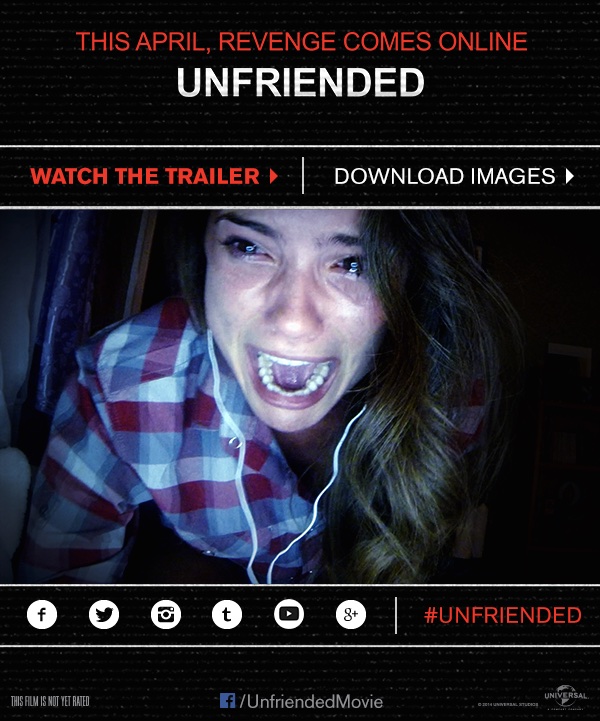
Warning this review contains a shed-load of spoilers for the movie.
As pretty much everyone knows, the movie is set on Skype. We don’t see anything other than the computer screen of the main character, Blaire. Of course, we see all the characters faces through the Skype call, but mostly the audiences sees a computer screen. Very modern. I liked it a lot. I also liked little tit-bits you could see on Blaire’s computer screen. The log in to her Tumblr, the things she kept on her task bar, the music she liked when she looked for music to play, recently talked to friends on her Facebook, etc etc. I, personally, am a huge fan of sounds, especially those featured in this movie. Because this movie takes place more or less on a computer, there’s the clicking of the mouse pad, the ever-present tap-tap-tap of the keys, the notification noises for Skype, Facebook or iMessage, it all feels very real!
Now, I usually don’t do horrors. The last time I looked into something labelled a horror was Five Nights at Freddy’s, and let me tell you, while the first and third game hardly phased me, the second game made me sleep with the bedroom light on for at least a week. I am absolutely the weakest when it comes to horrors, so I don’t really know why I agreed to go and see Unfriended with my friends when I did!
So, the lights dim and the movie starts and everyone begins to get a little excited and already a little scared. It starts out pretty simply, just friends on Skype, and then things get a little weird. And by “a little” I mean “a lot”.
At first, things are just a little creepy, and it seems as if the problem is easily resolved. It does just look like the dead girl, Laura Barns, account has been hacked. It’s something easy to fix, but when it’s tried, that’s where things get weird.
Before anything real happens, me and my friends noticed that there was a lot of foreshadowing in this movie. For one, Blaire tries to get Laura Barns Facebook page memorialized, fills out the form to complete this, and sends it in. After the page loads, all the text boxes are filled with the same three words: I GOT HER. When you’re first watching it’s an odd thing to see, but probably not unusual for a horror. But at this point in the movie, it just doesn’t make sense. Later on, in the last few moments of the film, we see Blaire filming the video of Laura Barns, and we see a cut out scene at the end of it, where Blaire giggles and whispers: “I GOT HER!”
Next thing, another character, Mitch, pretends to be threatening and points a knife at his computer screen while talking to just Blaire. (This is at the very beginning, way before anything gets real.) Towards the end, he is killed with a knife.
Another character, Adam, flamboyantly throws around a gun. Guess what his death involves? That’s right. A gun.
If you’ve seen the trailer, which I assume many have, you see that one character, Ken, gets his hand shoved into a blender. A good while before things start to go sour, he proclaims that he has a drink, and shows his blender on the screen.
One character, Jess, is in the middle of straightening her hair during the Skype call before things get weird. The last we see of her is her sat in the bathroom, screaming over the same pair of straighteners in her mouth.
It’s interesting, that’s for sure. Everyone wants to know who filmed or posted the video, everyone is scared of whose going to die, or what jumpscare is coming next. It draws you in, you want the knowledge, you want to know what happens next, you want to know what the next sentence in the demented game of “Never Have I Ever” is going to be, and what the consequences will be, you want to see if they turn against each other, you want to see how it ends.
The scariest thing in the movie, for me, wasn’t the jumpscares. Sure, they got me. The movie was loud, of course I jumped! But the thing that absolutely wrecked me was at the very, very end of the movie, all of Blaire’s friends are now dead, She’s the only one still alive, maybe, you think, she’ll get out of this alive. But then the lights in her house turn off, and everything is silent. Everything is silent for too long. And you know the suspense feeling, I’m sure. It’s been quiet too long, you assume that it’s safe to stare right at the screen. And then it happens, and it ruined me. Her bedroom door creaks open, and then it’s silent again for far too long. That’s it. It was that creak that ruined me the most. I felt like something was crawling up my back, ready to twist my neck, or worse. Her scream after the silence was nothing compared to the creak, for me. Even though the jumpscare was loud and bright and very, very flashy, it was over in seconds. But that creak could happen any time and remind me of that one moment in the film.
It was very intriguing, very scary, and very, very good. Since I am no connoisseur of horrors, and have not watched a great deal of them, I would have to say this is my favourite one. I would watch it again, mostly because this time around I would be much braver. Myself and my friends had a good time discussing it in the cinema and as we left, picking up on the foreshadowing, taking the movie apart, saying what we thought was good, and also saying what we missed because we were too scared to look at the screen.
The only thing I found unrealistic about the film, and something I’m not surprised that I picked up on, was the fact that on Blaire’s computer, she didn’t have “Press Enter to Send” ticked on her Facebook. I don’t know why that piqued my interest, but I think I just noticed it because, well, who really has that button unticked?
Overall Unfriended was very good and I enjoyed it a lot.
Review Frank, Chapter Arts Centre by Hannah Goslin.
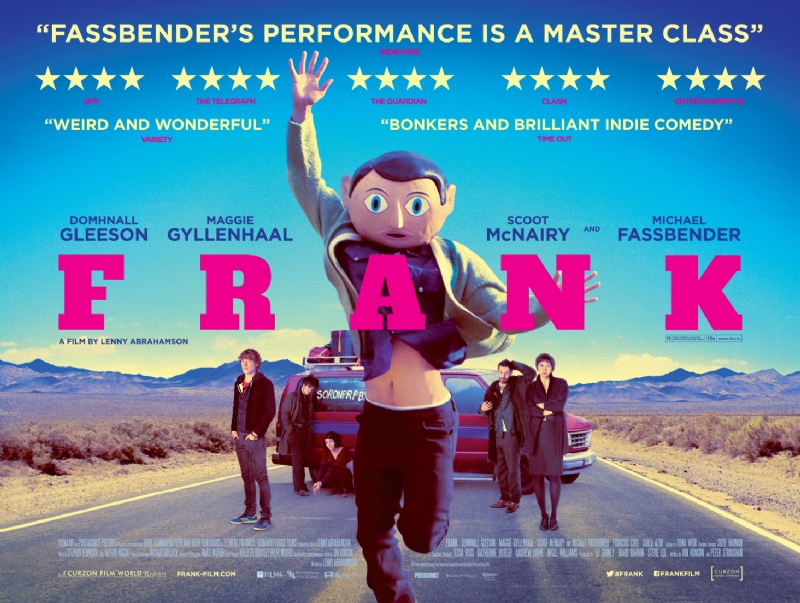
Frank
Chapter Arts Centre
Hannah Goslin
22/05/14
The red room of Chapter was a lovely set up to see this indie film. With its small capacity, the sold out show had a feeling of cosiness which would be more expectant and welcomed of an independent film.
My excitement for this film had been brewing for a while, with my admittant admiration and ‘crush’ on Irish actor and son of acclaimed actor Brendan Gleeson, Domhnall Gleeson. After seeing him in films such as Harry Potter, About Time and Anna Karenina, I knew that we would be in for a good performance. The character of Frank played by Michael Fassbender and an appearance from Maggie Gyllenhaal, is also a very welcomed addition.
Frank sees the tale of a average British man (Gleeson) called Jon who lives a normal life in a seaside town, still living with his parents and taking on an office job when really he is wishing for stardom as a musician… however his inspiration and ability to create music is seriously flagging. By chance, he meets this strange and unusual band who take him on as a last minute keyboard player. Jon’s life is soon completely changed, with travels to a remote part of Ireland for over a year to try and create an album of the most strange music you have ever heard. His use of social media transports the band into an online famous identity, bringing the band to Texas where this odd and close band are not accepted in the real world, and who’s relationship is torn apart.
This indie film was everything you wanted from a film with such a strange image in the public – a normal stature of a man with a exaggerated Paper Mache head. It was very comical throughout, with every actor having its moments of this, whether it was from the naivety of Gleeson’s character Jon who was from a suburban ordinary home thrown into this band where each character has its own abnormal past and/or traits to Gyllenhaal’s welcoming face contrasted to her sheer hating and negative personality.
The aesthetics of the film are simple and beautiful. Lovely and tranquil shots of a British seaside suburban town, the lake and rolling hills of the Irish huts they stay in and the vast sun drenched desert of Texas. Not only have the locations been well thought about but the band itself have – 5 Americans who all look pale with dark hair, dark vintage clothes all as if they have all come from a cloning facility. Gleeson’s well acted complete British-ness and bright ginger hair creates this outsider approach for Jon from the band, which highlights the storyline will his lack of acceptance by everyone but Frank.
Fassbender is also incredible. With no way of showing facial expressions, the large head of Frank still somehow manages to convey a range of emotions that the character faces, with Fassbender able to conduct the rest of his visible body in a way that complements this. Even now, this is confusing and admiring as it is uneasy to think how this is at all possible; how can an actor with no facial expressions convey so much and make you laugh, cry and feel for him without this. Eventually we learn of Frank’s unstable mental abilities, and this is transferred in hindsight through the hole film with Gyllenhaal and Gleeson’s character’s torment and fight against one another to look after him in his naive and child like state which at first we misconstrue as a sense of creativity.
Over all, Frank is an amazing film to watch. It is hard to fault as it ticks every box for this such of film – from emotion both positive and negative, beautiful images from the landscape and in the general cinematography, the many many perfect comical moments to the stella performances from each and every actor, Frank is a film to cross off your bucket list.
